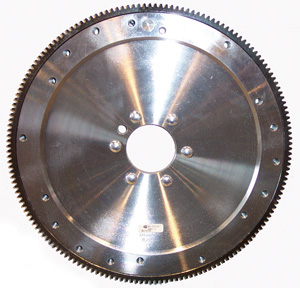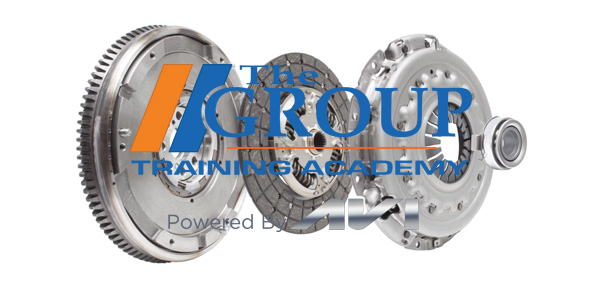● CLUTCH — Used with manual transmissions to engage and disengage the engine from the transmission and when shifting gears. The clutch is bolted to the flywheel on the back of the engine, and clamps the clutch disc against the flywheel when the clutch is engaged. When the clutch pedal is depressed to disengage the clutch, the pressure plate pulls away from the flywheel and disc, releasing the disc.
 The clutch is a spring-loaded pressure plate assembly. Most vehicles have a diaphragm spring clutch, but some older vehicles have a coil spring clutch.
The clutch is a spring-loaded pressure plate assembly. Most vehicles have a diaphragm spring clutch, but some older vehicles have a coil spring clutch.
If the clutch disc is worn or contaminated with oil, or if the clutch linkage is not adjusted properly, the clutch may slip. Slipping is most noticeable when the engine is under load, as when lugging at low speed in a high gear, when driving up a hill, when accelerating to pass another vehicle or when towing a trailer.
If a newly installed clutch is slipping, the most likely causes would be oil or grease contamination, incorrect release system adjustment, a defective cable adjuster, a blocked clutch master cylinder port or binding slave cylinder, a misaligned or improperly installed release bearing, or improper flywheel machining of a step or cup flywheel.
Because of the labor involved to replace a clutch, recommend replacing all the major clutch components at the same time: the clutch, disc, release bearing and pilot bearing/bushing (if equipped). A complete clutch kit will provide all the parts your customer needs. A kit also means the parts are properly matched for the vehicle application.
For towing or performance applications, larger, stronger clutches are available to upgrade driveline reliability and performance. Recommend upgrading to a performance clutch if your customer has had repeated clutch failures or is heavily modifying his engine.
● CLUTCH DISC — A flat plate with friction facings on both sides that allows engine torque to drive the transmission. The disc is mounted between the flywheel and pressure plate, and is connected to the transmission input shaft with a splined hub. The hub may be rigid (no springs) or have five to eight springs to help cushion clutch engagement. The disc facings provide friction and grip as they rub against the flywheel and pressure plate. Over time, the facings wear and reduce the clutches ability to hold under load. Eventually the clutch starts to slip and must be replaced. Slipping or chattering (jerky engagement) also can be caused by glazed or burned facings, or oil contamination. Oil leaks must be fixed before installing a new clutch disc. A “pilot tool” is required to center the disc when it is replaced.
● RELEASE BEARING — A bearing that slides around the transmission input shaft and pushes (or in some cases pulls) against fingers or the spring in the pressure plate to disengage the clutch. The bearing is held by a yoke lever attached to the clutch linkage and clutch pedal, or a telescoping hydraulic linkage inside the bellhousing. When the pedal is depressed, the clutch linkage pushes the release bearing forward against the fingers on the clutch plate. This relieves spring tension, allowing the pressure plate to release the clutch. Adjustment of the linkage is important for proper clutch engagement and release, as well as bearing life. A chirping noise that intensifies when the pedal is slowly depressed usually indicates a bad release bearing.
● PILOT BEARING/BUSHING — A small bushing or bearing located in the end of the crankshaft that supports the transmission input shaft. Used primarily on rear-wheel drive vehicles. Failure can cause noise or clutch release problems. Replacement is recommended when servicing the clutch or flywheel.
● FLYWHEEL — A large heavy wheel bolted to the back of the crankshaft that helps maintain engine momentum and serves as both a friction surface and heat sink for the clutch. The face of the flywheel must be smooth and flat for proper clutch engagement. It also must be free from cracks, hard spots or oil contamination. Resurfacing the flywheel is recommended when the clutch is replaced to restore the friction surface.
Some engines have a “dual mass” flywheel, which is like two flywheels in one. A dual-mass flywheel is supposed to dampen engine vibrations and cushion clutch engagement for smoother operation. If a dual-mass flywheel is cracked, damaged or the internal springs have failed, it needs to be replaced. Some dual-mass flywheels (Ford) can be resurfaced, but others (GM, BMW and Porsche) should only be replaced. Dual-mass flywheels are very expensive. One alternative is to replace them with a conventional one-piece aftermarket flywheel. These are available for Ford and GM, but they require a different clutch set than the OEM dual-mass flywheel. Replacing a dual mass flywheel with a solid flywheel may increase drivetrain harshness and vibration.
The flywheel also is used to start the engine. Gear teeth around the circumference of the flywheel are engaged by the starter to crank the engine. Missing or damaged teeth can interfere with reliable starting. If the gear is damaged, the ring gear or flywheel should be replaced.
When removing a flywheel, the flywheel’s index position on the crankshaft should be marked so it can be reinstalled in the same position as before. This is necessary to maintain proper balance on some engines.
● CLUTCH MASTER AND SLAVE CYLINDER — The master clutch cylinder is attached to the clutch pedal, and pushes fluid through a hose to the slave cylinder, which is connected to the release bearing or bearing yoke. Failure of the master or slave cylinder or a loss of fluid will prevent the clutch from releasing. Replacement is required if either is component is leaking.
● CLUTCH CABLE — Used on some older vehicles to connect the clutch pedal to the release bearing yoke. Most cables have an automatic adjuster that maintains proper clearances between the release bearing and clutch. If the cable breaks, the clutch cannot be released. If it sticks, it can prevent proper engagement. Replacing the cable is recommended when changing the clutch.
Ignition System
Manual Transmission/Transaxle Parts
Emission Controls
Driveline Components













